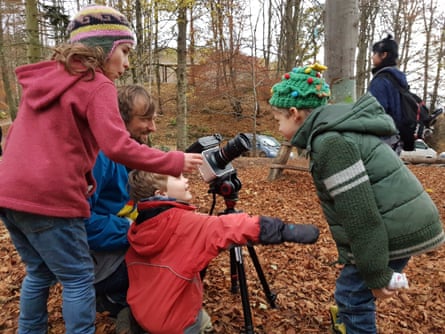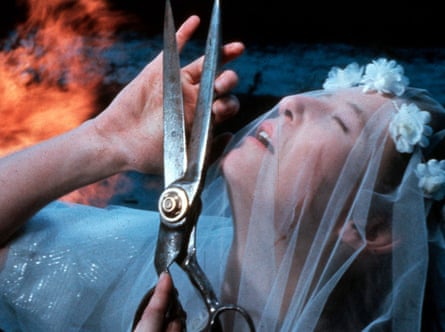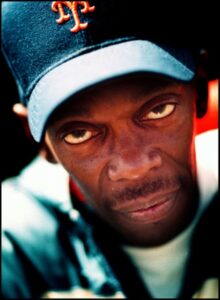‘This is a film about learning, full of questions, with not many answers,” announces Tilda Swinton at the start of her new documentary, The Hexagonal Hive and a Mouse in a Maze. “It has been dreamt up by the Derek Jarman Lab between 2016 and 2042, in conversations with thinkers both living and not, a caterpillar and one or two algorithms.”
It’s a useful heads-up that the film, co-directed by Swinton with Bartek Dziadosz, is no conventional piece of storytelling or analysis. The words “dreamt up” are telling too, for The Hexagonal Hive – which premieres at Sheffield DocFest this week – has the floating, freewheeling atmosphere of a dream. It collects ideas about neuroscience, education and the world of work, and creates a sensory collage that includes footage from Scotland, Bangladesh and west Africa, with gnomic captions such as: “What a machine the world is – how to work its gears?” It also features the voices of academics and children, as well as clips from Night of the Hunter and My Neighbour Totoro.
The film keeps one eye on the practices of traditional societies and another on the unfolding AI revolution threatening to upend the modern world. ChatGPT, Midjourney and Synthesia are all mentioned in the credits; an AI-created avatar addresses us at various points; and a researcher from 2042 sends us dispatches from the future. It is quite a trip, puzzling, beguiling and thought-provoking.
“We knew from the first,” says Swinton, “that what we were most interested in was our own curiosity about the subject, and that we wanted to steer clear of drawing any conclusions. We wanted to accurately represent the sort of ‘thought cloud’ of our rambling conversations. And the more we explored the range and disparate blind alleys and byways of our wonderings, the more aware we became that a film mapping our inarticulacy might look something like a learning machine, even an unconscious, grappling mind.”

The film is the second feature-length product of the Derek Jarman Lab – the production and editing centre at Birkbeck, University of London, named after the great avant-garde director with whom Swinton worked on nine films, including her 1986 debut Caravaggio. She remembers Jarman as a “great encourager”, whose collective approach to film-making has inspired the work of the lab – including Swinton and Dziadosz’s previous documentary, 2016’s The Seasons in Quincy: Four Portraits of John Berger.
The Hexagonal Hive took time to evolve, starting with footage shot in 2016-17 at Drumduan, the Steiner school in Scotland that Swinton helped found and sent her own children to. These scenes give an insight into its unconventional approach, in which the teaching of practical skills such as constructing the six-sided beehive frame of the film’s title is favoured over rote learning and exams. The directors then travelled to Bangladesh, where they visited schools and a tea estate. Later, they added material from Ghanaian film-maker Anita Afonu, including a stunning sequence in which two boys construct a basket with amazing skill.
As the project developed, the directors began to think about the film “as a story or a poem about learning”, Dziadosz says. Contributing to the conversation they wanted to generate are many different voices from interviewees who are neither seen nor named as they would be in a conventional documentary, at least not until the end credits. Some are academics, others children. “That’s a way of presenting all these voices on the same level,” says Dziadosz. “When you can’t connect the voice with some sort of authority or credentials, you really listen to the substance.”

Trying to catch the peculiarity of a child’s perspective leads the film to Alice’s Adventures in Wonderland. Swinton reads from Lewis Carroll’s book – the caterpillar that was mentioned at the start turns out to be Alice’s pipe-smoking interlocutor – and there are clips from Jan Švankmajer’s 1980s Czech film adaptation.
“The rabbit hole felt like an accurate place to aim ourselves at,” says Swinton. “That book holds an unfailing capacity to unnerve and resonate – especially as a record of the experience of a certain slice of consciousness from childhood, with the switchbacks between perils and euphoria, self-doubts and posturings. We wanted to anchor ourselves in that molten, uncomfortable, exhilarating atmosphere of wild adventure.”
after newsletter promotion
But as well as drawing on past texts, the film looks ahead to the transformative but unsettling future promised by AI. The “mouse in a maze” of the title was an early prototype of machine learning: an electrically controlled model rodent called Theseus, that worked out how to escape from a mini-labyrinth in a 1952 experiment.

Swinton sets out the challenge starkly: “We are acutely aware that we stand on a precipice facing a future that is ever more urgently calling for new thinking: about the nature of consciousness as much as about education, and what an appropriately empowering education for the next few decades might look like. This precipice is severe enough for us to be respectful of the need to examine all possible questions before jumping into the reflex of formulating solutions. So we set ourselves the rare chance to wonder freely – a state of suspension.”
For Swinton, the revolution in no way undermines the focus on “flexibility and groundedness” that is the hallmark of Drumduan School. “It occurs to me that there is no revolution imaginable for which this essential foundation might not be invaluable,” she says. “The question of what it is to be human in the first place – before we became, as most of us now are, bionic, and now, in our ever-expanding landscape with its new relationships and inter-dependencies – seems to me to be a worthwhile territory to explore for all of us.”
Source: theguardian.com





















